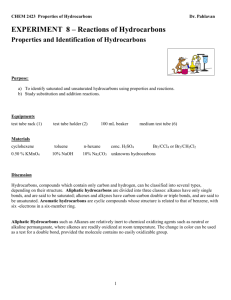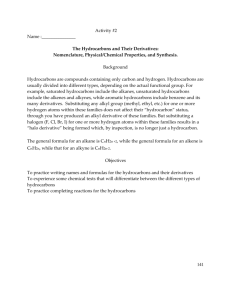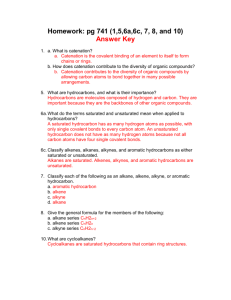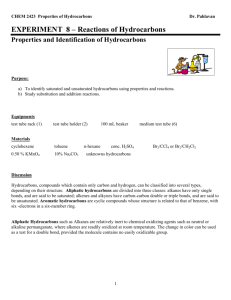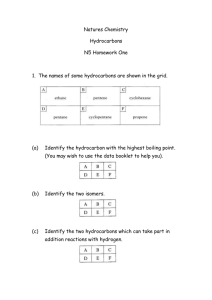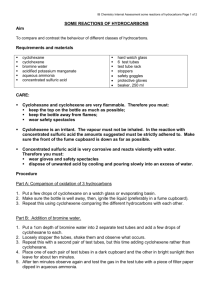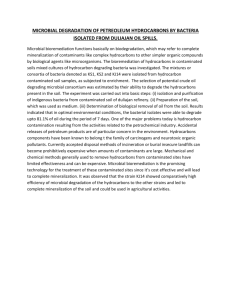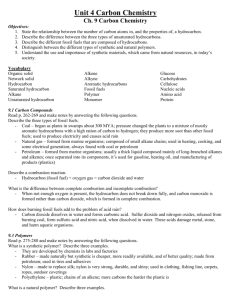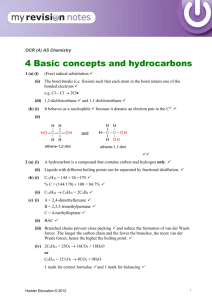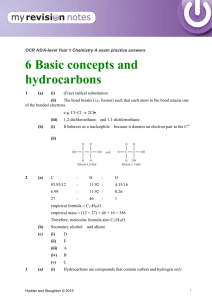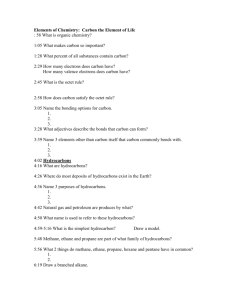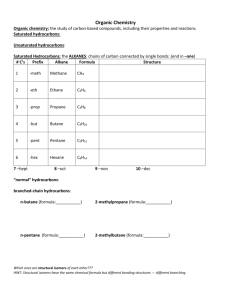hydrocarbo
advertisement
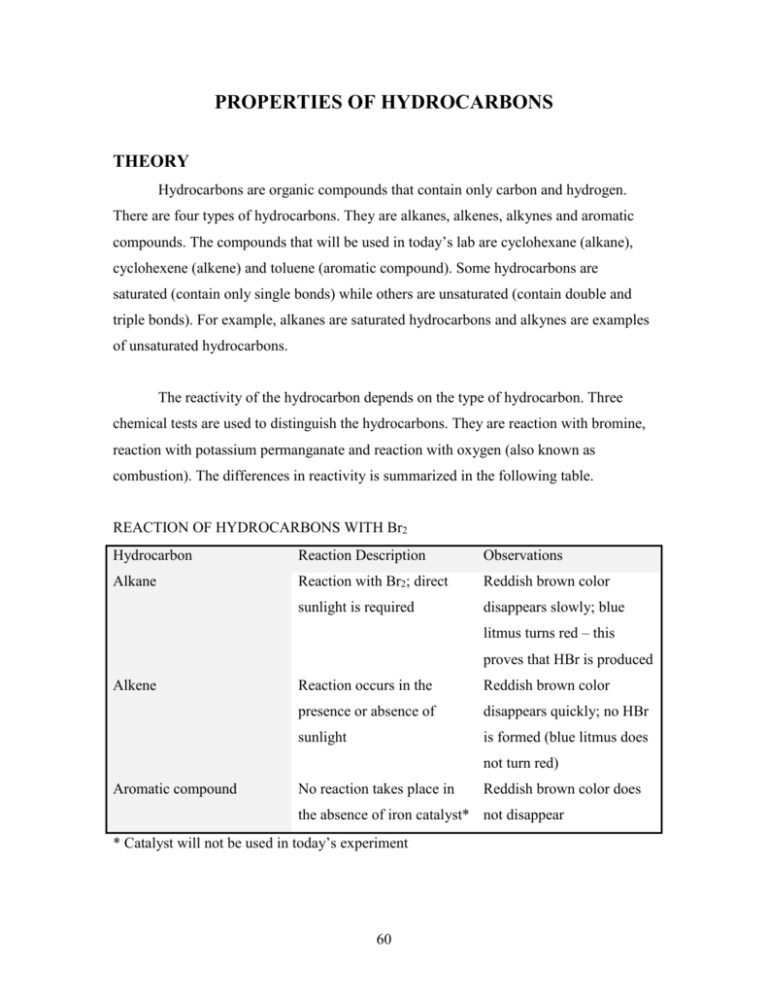
PROPERTIES OF HYDROCARBONS THEORY Hydrocarbons are organic compounds that contain only carbon and hydrogen. There are four types of hydrocarbons. They are alkanes, alkenes, alkynes and aromatic compounds. The compounds that will be used in today’s lab are cyclohexane (alkane), cyclohexene (alkene) and toluene (aromatic compound). Some hydrocarbons are saturated (contain only single bonds) while others are unsaturated (contain double and triple bonds). For example, alkanes are saturated hydrocarbons and alkynes are examples of unsaturated hydrocarbons. The reactivity of the hydrocarbon depends on the type of hydrocarbon. Three chemical tests are used to distinguish the hydrocarbons. They are reaction with bromine, reaction with potassium permanganate and reaction with oxygen (also known as combustion). The differences in reactivity is summarized in the following table. REACTION OF HYDROCARBONS WITH Br2 Hydrocarbon Reaction Description Observations Alkane Reaction with Br2; direct Reddish brown color sunlight is required disappears slowly; blue litmus turns red – this proves that HBr is produced Alkene Reaction occurs in the Reddish brown color presence or absence of disappears quickly; no HBr sunlight is formed (blue litmus does not turn red) Aromatic compound No reaction takes place in Reddish brown color does the absence of iron catalyst* not disappear * Catalyst will not be used in today’s experiment 60 REACTION OF HYDROCARBONS WITH KMnO4 Hydrocarbon Reaction Description Observations Alkane No reaction with KMnO4 Purple color does not disappear Alkene Reaction takes place Purple color disappears quickly; formation of brown precipitate, MnO2 Aromatic compound No reaction takes place Purple color stays REACTION WITH O2 (COMBUSTION) Hydrocarbon Reaction Description Observations Alkane Reacts with O2 Burns with no soot formation Alkene Reacts with O2 Burns with a sooty flame Aromatic compound Reacts with O2 Burns with a sooty flame OBJECTIVES 1. Examine the physical and chemical properties of hydrocarbons. 2. Identify the type of hydrocarbon in common everyday chemicals. PROCEDURE A. SOLUBILITY TESTS 1. Place 10 drops of cyclohexene, cyclohexane and toluene in three separate, clean, dry test tubes. Add 10 drops of water to each test tube. Note whether the hydrocarbons dissolve. 2. Repeat the test in methylene chloride. Do the hydrocarbons dissolve? B. REACTION WITH BROMINE* (OPTIONAL) Place 10 drops of cyclohexene and cyclohexane in separate test tubes. Add 2 drops of 5% Br2/methylene chloride solution. Does a reaction 61 occur? Place the test tube containing cyclohexane and bromine solution under a sunlamp and check whether hydrogen bromide gas is evolved. This may be done by holding moist blue litmus paper at the mouth of the test tube. Bromine is hazardous and extremely harmful. Wear gloves and work in the assigned hood space only. C. REACTION WITH POTASSIUM PERMANGANATE Place 10 drops of cyclohexane, cyclohexene and toluene in three separate test tubes. Dissolve the hydrocarbons in 2 mL of ethyl alcohol. Add 2 drops of 2% KMnO4 solution to each test tube. Does the purple color disappear? Is it replaced by a brown precipitate? For a positive reaction to occur, the color should disappear in less than 1 minute. D. REACTION WITH OXYGEN GAS (COMBUSTION REACTION) Place two drops of cyclohexane on a spatula and ignite the hydrocarbon with the Bunsen burner. Does the compound burn with a clean or sooty flame? Repeat the test with cyclohexene and toluene. E. TESTS WITH COMMON HYDROCARBONS Repeat bromine, potassium permanganate and combustion reactions for some common everyday hydrocarbons. These hydrocarbons will be provided by your instructor. Use 6 drops of liquid and 0.15 g of solid. Do not use sunlamp when you perform the bromine test. 62 OBSERVATIONS A. SOLUBILITY TESTS Hydrocarbon Water CH2Cl2 Cyclohexane Cyclohexene Toluene (B – D) REACTION OF HYDROCARBONS WITH Br2, KMnO4 and O2 Hydrocarbon Br2 KMnO4 O2 Saturated/unsa Type of turated Cyclohexane Cyclohexene Toluene 63 hydrocarbon E. REACTION OF COMMON HYDROCARBONS WITH Br2, KMnO4 and O2 Sample Br2 KMnO4 O2 Unleaded gasoline Turpentine Mothballs Paraffin Polyethylene Polystyrene 64 Saturated/ Type of unsaturated hydrocarbon QUESTIONS 1. Draw the structures of any three hydrocarbons used in this experiment. Indicate which is an alkane, alkene and which is aromatic. 2. Explain why the hydrocarbons dissolve in one solvent, but not the other. 3. Write an equation for the reaction of cyclohexene with bromine. 4. Write equations for the reaction between cyclohexene and potassium permanganate. 5. Compare the amount of soot that was produced when various hydrocarbons were burned. 65
